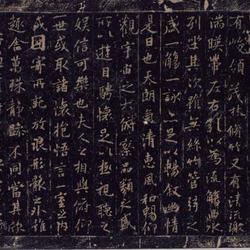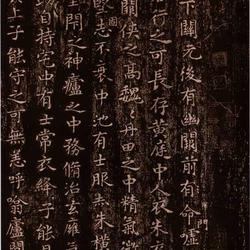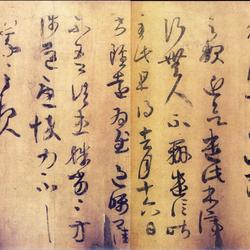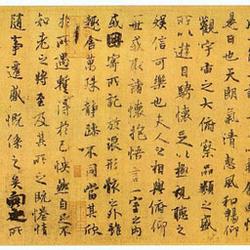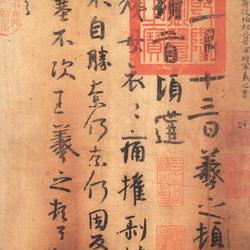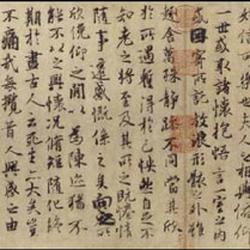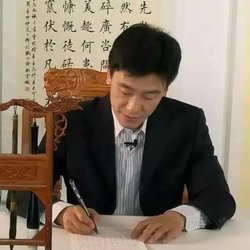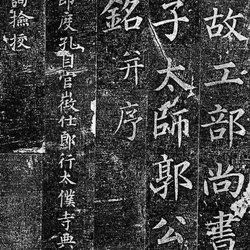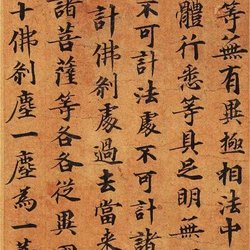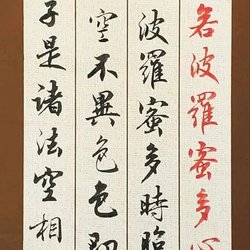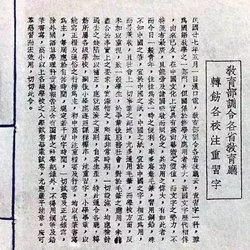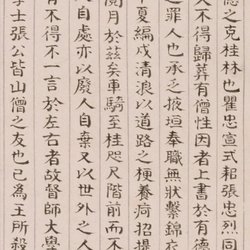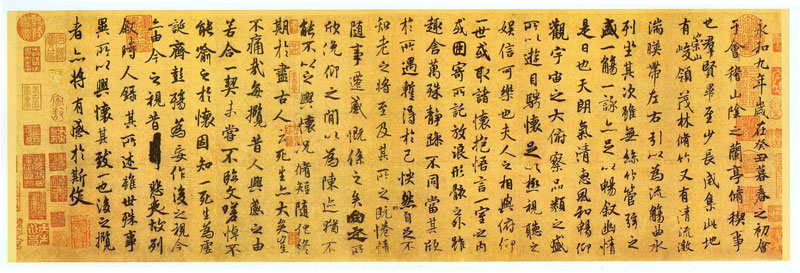
Volume "Preface to Orchid Pavilion by Chu", Tang Dynasty, copy by Chu Suiliang, paper, running script, 24cm in length and 88.5cm in width. Collection of the Palace Museum, Beijing
The original "Lanting Preface" was written by Wang Xizhi, a famous calligrapher in the Eastern Jin Dynasty. Its beautiful and graceful wind spirit was regarded by later generations as a model and model for running calligraphy. Li Shimin, Emperor Taizong of the Tang Dynasty, loved Xi Zhi's calligraphy. After obtaining the authentic copy of "Lanting Preface", he ordered the famous calligraphers Chu Suiliang and Ouyang Xun, as well as Feng Chengsu, the calligrapher of Hongwen Hall, to copy several copies and give them to his ministers for widespread dissemination. According to records, the original work was buried with Emperor Taizong of the Tang Dynasty in Zhaoling. There are two main systems for these Tang Dynasty copies. One is Chu Suiliang's copy. The surviving ink copy of Chu Suiliang, Yu Shinan, Feng Chengsu and others mostly belong to this system, with Feng's "Shenlong version" being the best; the other is Ouyang Xun's copy. The "Dingwu version" of the engraved calligraphy originated from the European version and is the best stone-engraved calligraphy version in existence.
This volume is designated as the Preface to Chu's Copying of Lanting, based on the title "Chu's Copying of Wang Xizhi's Orchid Pavilion" in Xiang Yuanbian at the beginning of the volume. At the same time, there are poems inscribed by Mi Fu in the volume, so it is also called "Mi Fu's Poems Inscribed Edition".
The whole volume contains inscriptions or inscriptions from various scholars in the Song, Yuan and Ming dynasties, as well as 215 seals and 4 half-prints. Among them, 2 Northern Song Dynasty seals including "Tengzhong" and 7 jade seals of Shaoxing Neifu in the Southern Song Dynasty, including "Shaoxing", "Neifu Seal" and "Ruisi Dongge" are authentic. On the first back of the paper, Mi Fu's poem title and 7 square seals are genuine. The seal is also true. The inscriptions and seals on the paper followed by Mi Fu's poem, including those of Fan Zhongyan, Wang Yaochen and Mi Fu, are all fake and must have been written in the late Southern Song Dynasty. The inscriptions from the Yuan and Ming dynasties on the subsequent paper are all genuine, but they are suspected to have been added elsewhere.
Later, the paper inscriptions and seals were verified, and this volume should be a copy made by Mi Fu in the Northern Song Dynasty. It is also believed that the texture of the work is Pupi paper, which was commonly used after the Song Dynasty. This also proves that this is a copy of the Northern Song Dynasty. The whole volume is composed of two pieces of paper, with 19 lines on the front paper and 9 lines on the back paper. The lines are arranged more evenly, and the stipple brush is less sharp, which is similar to the quill writing style of Jinzhen's "Feng Feng Lanting Preface" (Shenlong Edition). The style is very different, and it is also different from the Tang copy of the ink drawings based on Chu's copy. It must belong to the Song copy of the ancient copy that was copied repeatedly after the Tang Dynasty. This volume is mainly based on temporary writing, supplemented by outlines, so the writing is relatively smooth and has a certain skill.
The circulation and collection process of this volume are roughly as follows: Tengzhong in the Northern Song Dynasty, Shaoxing Neifu in the Southern Song Dynasty, Zhao Mengfu in the Yuan Dynasty, Zheng family in Mingpu Jiang, Xiang Yuanbian, Bian Yongyu in the Qing Dynasty, and Neifu in Qianlong. It has been recorded in Gu Fu's "The Spectacular Life" of the Qing Dynasty, Bian Yongyu's "Research on Calligraphy and Painting in Shigutang", Wu Sheng's "Daguan Lu", An Qi's "Moyuan Collection", "Shiqu Baoji · Continuation", Ruan Yuan's "Shiqu Essays", etc. book and engraved with "Eight Pillars of Orchid Pavilion".
(Writer: Shan Guoqiang)

